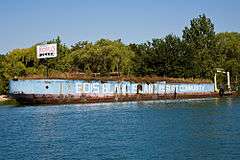Bois Blanc Island (Ontario)
| Bois Blanc Island, Ontario Boblo Island | |
|---|---|
| Island | |
|
Shore of Bois Blanc Island | |
| Coordinates (Dance hall): 42°05′44″N 83°07′14″W / 42.09556°N 83.12056°WCoordinates: 42°05′44″N 83°07′14″W / 42.09556°N 83.12056°W | |
| Country | Canada |
| Province | Ontario |
| County | Essex |
| Waterway | Detroit River |
| Town | Amherstburg |
| Area | |
| • Total | 0.425 sq mi (1.10 km2) |
| Time zone | EST (UTC-5) |
| • Summer (DST) | EDT (UTC-4) |
| 272 acres (110 ha) = 0.425 sq mi (1.10 km2) | |
Bois Blanc Island, commonly called Boblo Island, is an island in the Detroit River on the Canadian side of the border and is part of Amherstburg, Ontario. The island is about 2.5 miles (4 km) long, 0.5 mile (0.8 km) wide and 272 acres (110 ha) in size.
The main northbound shipping channel of the Detroit River currently lies between Bois Blanc Island and the Amherstburg mainland. A stone lighthouse was built in 1836 on the southern tip of Boblo island which marks the historical beginning of the Detroit River navigation channel for ships traveling upriver from Lake Erie in more modern times.
Bois Blanc means "White Woods," a name derived from the many birch and beech trees in the area. "Boblo" is an English corruption of the French pronunciation of the name. Several islands with the same name dot the Great Lakes, and nearly all are known as "Boblo" or "Bob-lo" by the local populations.
The island had strategic importance when Fort Amherstburg (now Fort Malden) was built in 1796 to guard passage along the Detroit River after Detroit was turned over to the Americans. Guns from the fort could reach the island across the navigable waters and hence secured the river.
Boblo island has a very rich history, it's association with the ancient Sauk Trail, the earliest European reference made about the island in 1718, which describes 70 First Nation families peacefully farming the fertile land, later it became the place where French Catholic had a mission for the Wyandot (Wendat) First Nation (also known as "the Huron Indians") in the 18th Century, the location of the site of the headquarters for the Shawnee Chief Tecumseh ("Shooting Star") the leader of a large tribal confederacy (known as Tecumseh's Confederacy), during the War of 1812, and it was the location of the invasion point for 60 Canadian "Patriots" on January 8, 1838 during the Upper Canada Rebellion and also served as the stepping stone for numerous individuals on the Underground Railroad to Canada one estimate puts 30,000 people as having had crossed over between 1834 and 1860.
Boblo Island Amusement Park
Bois Blanc is known regionally as the former home of the Boblo Island Amusement Park, which began operation in 1898 and closed on September 30, 1993. The Nightmare, Falling Star, Wild Mouse, Sky Streak and Screamer were the signature rides.

For more than 85 years, the park was serviced by the SS Ste. Clair and the SS Columbia.
The Boblo Island Amusement Park was famous for those two steamers, which went between Detroit and the island. A lawsuit concerning the power of the state of Michigan to prohibit racial discrimination on the ferries, Bob-Lo Excursion Co. v. Michigan, 333 U.S. 28 (1948), reached the U.S. Supreme Court and resulted in a notable decision construing the Commerce Clause.
During the Vietnam War, when Canada had become a safe haven for those who refused to be drafted into the U.S. Army, Boblo Island became an efficient transit point for Americans who sought refuge from prosecution. Those seeking to pass into Canada would take the boat from Detroit to Boblo and, upon arrival, would trade their return tickets with persons who had arrived on the island from Amherstburg. Those who had come from Canada took the return trip to Detroit, and those who had come from Detroit took the return trip to Amherstburg, thus arriving in Canada without having to pass through Customs at the border.
Today
The island is currently being developed as Boblo Island and Marina Resort Community by Amico Properties Limited. Boblo Island now has a community of homes and condominiums. The island is served by a private ferry.
A partial restoration of both of the steamships, Columbia and Ste. Clair, was made for the 2014 feature film Transformers: Age of Extinction.[1]
See also
References
- ↑ "Historic Boblo boats land role in Transformers 4". CBC News. 11 July 2014.
Further reading
- Carlisle, annesla. Bob-Lo: An Island in Troubled Waters (Momentum Books, 2005) ISBN 1-879094-75-4 ISBN 978-1-879094-75-8
External links
| Wikimedia Commons has media related to Bois Blanc Island. |
- BOB-LO ISLAND AMUSEMENT PARK 1898-1993
- A 1984 Radio Commercial for Boblo Island
- Bois Blanc Island Lighthouse National Historic Site of Canada
- Walkerville Times: Long Live Boblo
